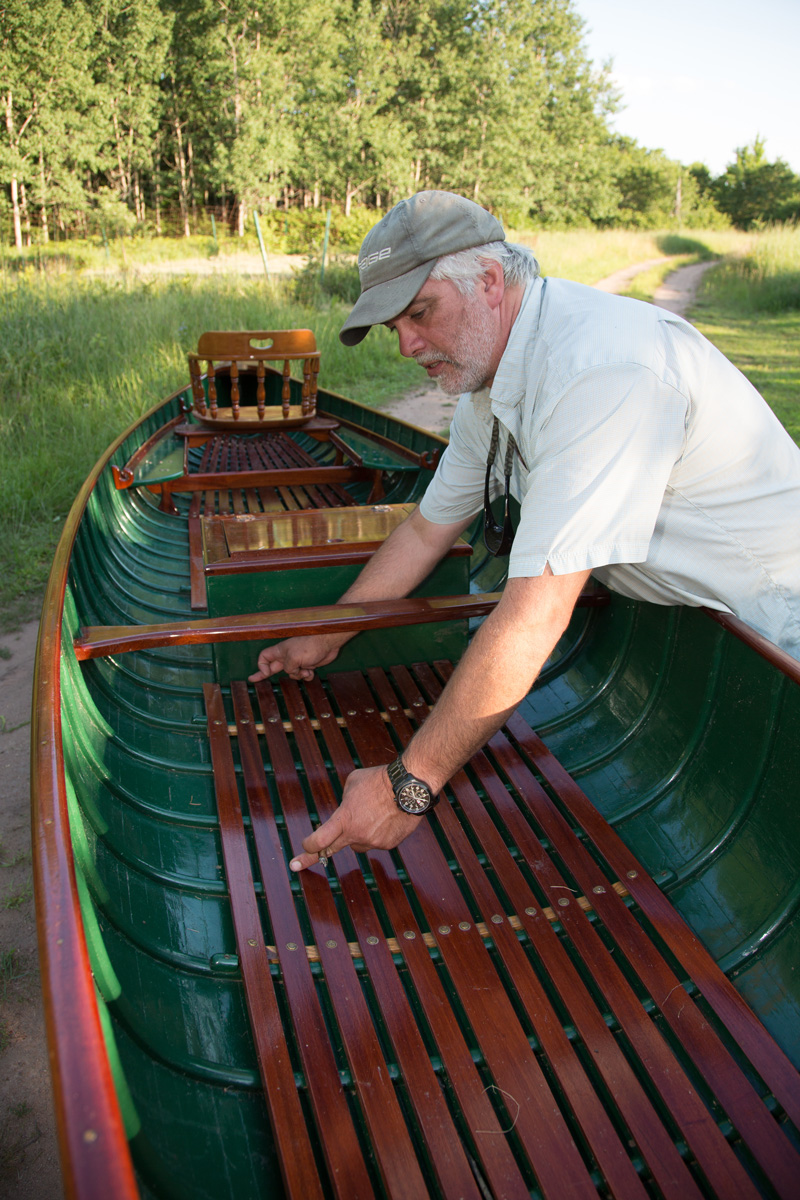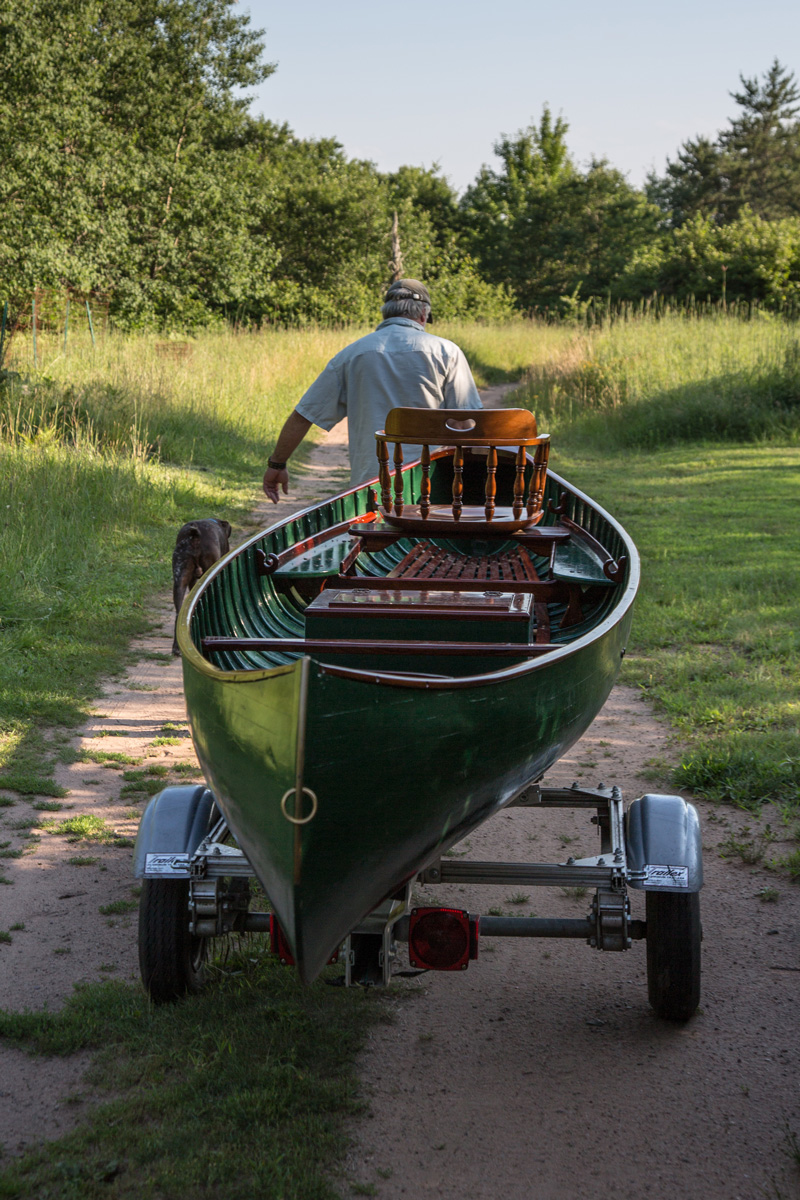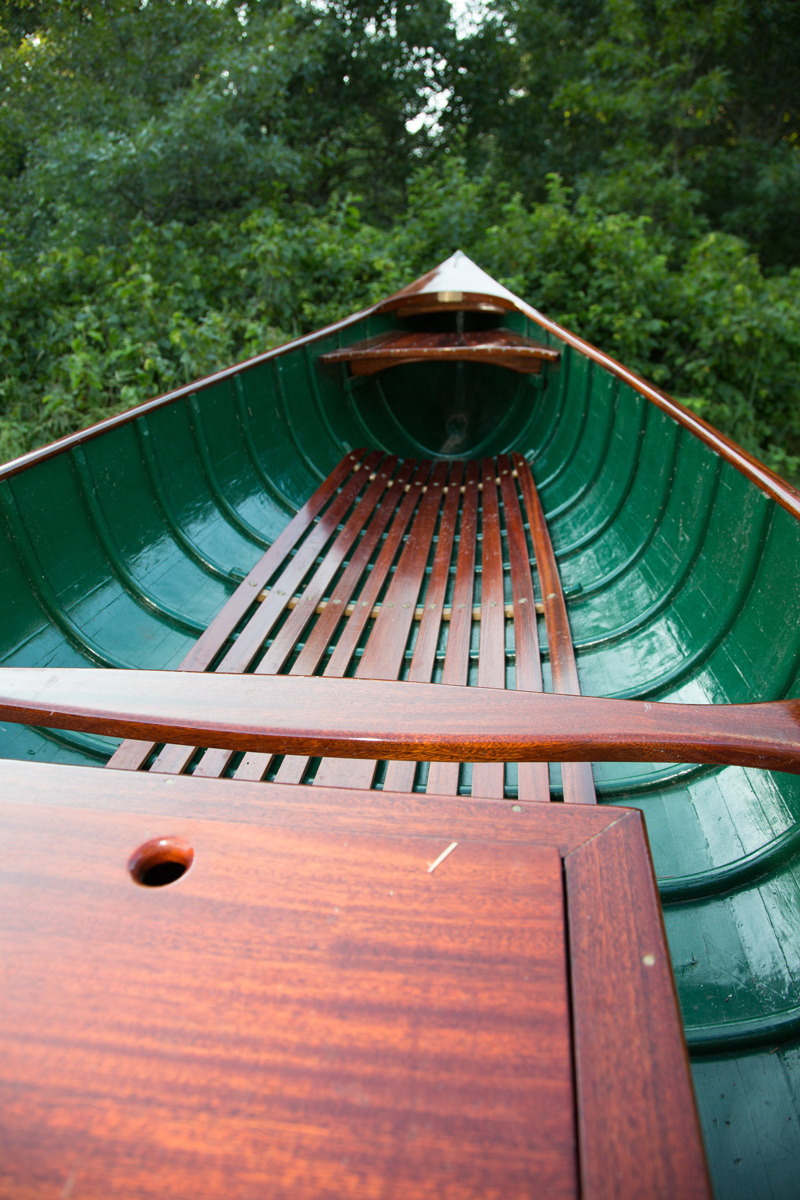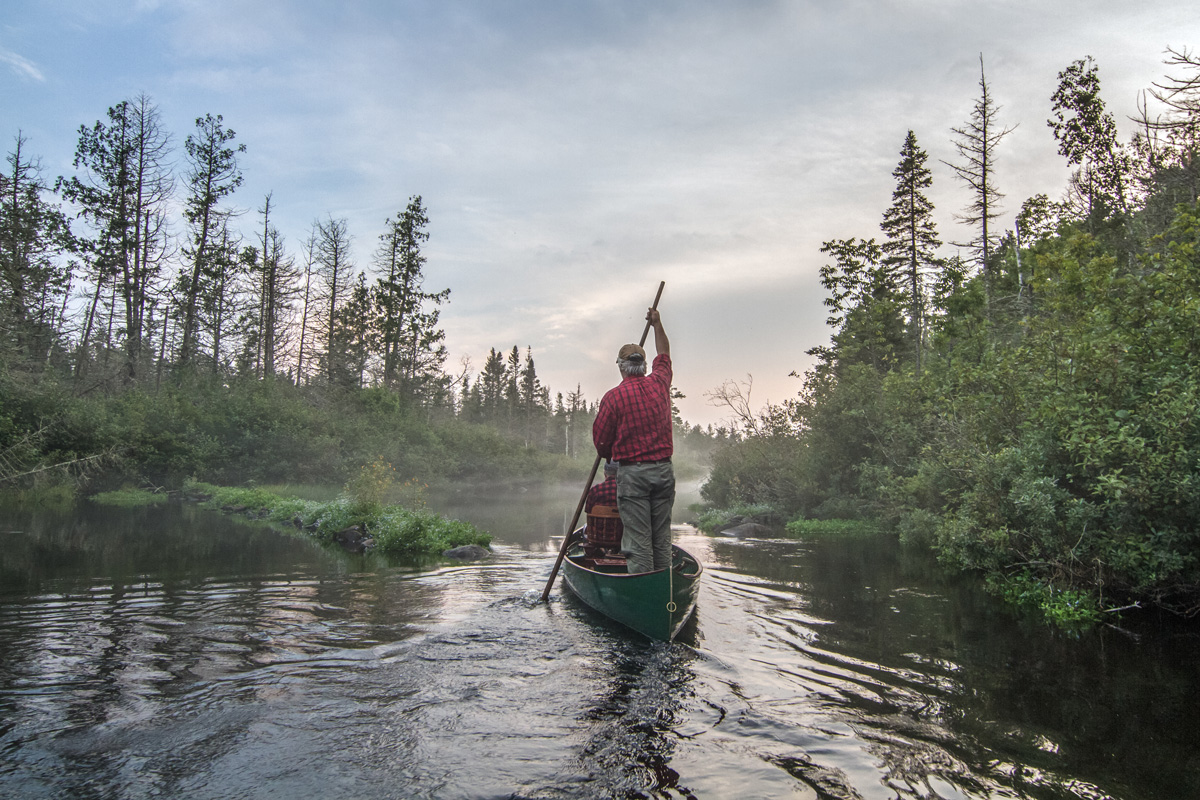Keith R. Crowley
If you press him hard enough, Damian Wilmot might tell you he’s a pretty fair fishing guide on a pretty fair trout stream in northwest Wisconsin. He’ll likely also tell you he’s an itinerant trout bum and bird hunter. He may even mention some of the incredible fur-trade era artifacts he has pulled from the Bois Brule, a river that was crucial to French voyageurs three centuries ago. But he will surely tell you about his meticulously restored Joe Lucius Guide Canoe.
Wilmot is immensely proud of that boat, and he should be. He spent two years resurrecting the 100+-year-old Lucius boat from certain doom, and now it’s a thing of aesthetic and functional beauty. Most importantly, it’s back ghosting over the Brule, serving as Wilmot’s guide boat. Calling the 20-foot canoe lovely is an understatement akin to calling Wilmot a decent fishing guide.
With a snow-white beard and an even whiter shock of tousled hair, the cigar-chomping, 50-something Wilmot looks the part of an Old Brule guide. He speaks with quiet reverence about the river, the fish, and especially the rivermen who came before him: men like Joe Lucius, Johnny LaRock, George Babb, and Johnny Degerman.

Brule River Guide Damian Wilmot releases a nice brown trout caught by angler Matson Holbrook while fishing from a 1895 Lucius guide canoe restored by Wilmot.
He has a special affinity for Lucius and his handmade guide boats. Wilmot believes the Lucius boat he rescued is circa 1900, maybe even as early as 1895, and hand built by Lucius on the banks of the great river. Resuscitating the craft and making it Brule-worthy didn’t happen easily.
It was part luck that brought this boat to Wilmot—and it was part destiny. He had helped restore another Lucius boat with local boat builder Stub Swenson a few years back and loved the way it handled the swift Brule waters. “There is nothing like fishing out of a wooden boat,” Wilmot exclaims. He enjoyed it so much that he was on the lookout for more of the wooden canoes. When he learned about this one, he immediately went to check it out. Lucius was a prolific builder, even if not many survive. “Those boats got used hard,” explains Wilmot, “but this one was really in a bad way. It was literally on its way to the dump at one point.
“Once I got it home and looked at it closely, I thought there was no way it could be done right. I was going to turn it into a planter in my yard,” says Wilmot. “Seriously. I was going to fill it with dirt and put flowers in it. But Stub reminded me that anything can be fixed, and Lloyd convinced me we should try to bring her back.
“I can’t begin to describe the condition it was in when I got it,” says Wilmot. “It had been stored in a boat shed where the roof had collapsed. The hull had caved in, and there were massive breaks on both ends of the boat.” All the ribs, the planks, the decks—everything needed replacement or major repairs. According to Wilmot, “It would’ve been so much easier just to build a new one from scratch. No one in their right mind would have looked at that boat and said, ‘let’s fix it.’”
But that’s exactly what he did.
Wilmot removed the shattered hull from a riverside shed and carted it to his friend Lloyd Hautajarvi’s workshop in Duluth, Minnesota, 40 miles away. Two years, 700 man-hours, and several thousand dollars in materials later, Wilmot guides out of it daily and sometimes runs the river just to run the river. “There’s no point leaving it sitting on the trailer,” Wilmot explains. “It was built for this river, and it’s tough enough to take whatever the Brule gives it.” The Brule has been “giving it” to boats for a long, long time. More than one modern canoe made of aluminum, fiberglass, or even Kevlar has had its spine broken on infamous Brule boulders.

Brule River trout guide Damian Wilmot describes the restoration process of his ca. 1895 Joe Lucius Brule Guide’s Canoe. Lucius guide boats featured built-in, tin-lined livewells and high-backed chairs for the angler. Wilmot and his friend Lloyd Hautajarvi meticulously restored the wooden boat over the course of two years and Wilmot now uses the boat in his daily guiding trips on the river, located near Lake Nebagamon, Wisconsin.
The 44-mile-long Brule draws people from around the world and has for centuries. The first European to travel the Brule was Daniel Greysolon, Sieur du Lhut, in 1680. Duluth, Minnesota, was named for this French soldier and explorer. Sieur du Lhut discovered that the headwaters of the Brule, flowing north to Lake Superior, came within a mile of the headwaters of the St. Croix River, flowing south to the Mississippi River and the Gulf of Mexico beyond. This short portage from one watershed to another made it a natural and efficient corridor for commerce—primarily furs in those days—from the center of the continent to the Atlantic and Gulf coasts.
Joe Lucius came to the Brule region in the early 1880s. He was a settler, a builder, and a fishing guide on the Brule and St. Croix Rivers. Lucius Lake and Little Joe Rapids on the Brule River are named for him, as is Lucius Woods a few miles away from the Brule in his adopted hometown of Solon Springs. He was a handy guy to have around, having learned much about building things that float at the shipyards in Superior, Wisconsin.

Brule River trout guide Damian Wilmot moves his ca. 1900 Joe Lucius Brule Guide’s Canoe into the light for examination. Wilmot and his friend Lloyd Hautajarvi meticulously restored the wooden boat over the course of two years and Wilmot now uses the boat in his daily guiding trips on the river, located near Lake Nebagamon, Wisconsin.
About the time Lucius arrived, lumber barons discovered the vast tracts of old growth white and red pine. Iron ore was also discovered nearby in both northern Michigan and northern Minnesota. Railroads crisscrossed the region, and commerce was king. Somehow, however, the Brule River Valley was left unscathed. Perhaps because of the region’s unique beauty, early settlers and anglers fought to hold back the forces of industry, and they succeeded: The Brule Valley looks much as it did in its primordial beginnings as the last ice age glaciers retreated north.
What the ice left behind was the perfect recipe for trout: Clear artesian springs feed the Brule headwaters with cold, pristine water. The sinewy upper river winds through wide bogs, alder-studded marshes, and upland swales until it narrows and begins a 35-mile-long descent toward Lake Superior. Mucky bottoms and shallow gravel runs lead into broad, still pools. The river darts between boulders and skips over ledges until it begins a steeper, faster run for its last dozen miles, where it dives through clay cliffs and slick passages to Lake Superior. In its upper reaches it is ideal trout-rearing water, and where there are trout there are trout anglers.
In years past, the Winneboujou Train Station platform, situated close to the midpoint of the river, was the busiest station on the river. Set on the rail line built by the Duluth, South Shore and Atlantic Railway, the Winneboujou Station saw thousands of anglers and countless trout cross its platform from the late 1800s through the mid-1900s. The Winneboujou Station, named for a mystical Anishinaabe (Ojibwe) prophet, is long gone, and now a steel and concrete bridge crosses the river there. But the landing itself is still a popular put-in and take-out point on the river.
Just upstream from Winneboujou lies the most storied part of the river. Famous fishing holes are found throughout the central section of the river. Just mention May’s Rips, Rainbow Bend, Lucius Lake, Wildcat Rapids, or McDougall Springs to the Brule faithful, and their heart rates will climb and their casting arms will start to twitch involuntarily.
As it has been for more than a century, the middle section of the Brule is home to numerous old estates owned by wealthy families from Duluth, St. Paul, Chicago, and beyond. For most of its modern history the Brule has been a summer getaway for families with names like Rand, Ordway, Congdon, and Weyerhaeuser. Originally they came for the clearwater springs, the cool summer days, and the brisk nights, but when they discovered the trout fishing, the legend of the Bois Brule was born. As word spread among the wealthy elite, big rustic lodges and compounds were constructed along the banks of the river. And they hosted some famous visitors.
Five U.S. Presidents have fished the Brule: Ulysses S. Grant was first, coming to the river in 1870. Grover Cleveland was next in 1880. Calvin Coolidge, Herbert Hoover, and Dwight Eisenhower all fished the “River of Burnt Wood.” Today, celebrities and VIPs still fly into a private runway just up the hill from Stone’s Bridge and another downstream at Cedar Island.
Most of them come for brief fishing sojourns, but when President Calvin Coolidge came in June 1928, he stayed for three months, making the Pierce Estate on the Brule’s Cedar Island his “Summer White House.” Legendary Native American Brule riverman Johnny LaRock guided him that summer, and Coolidge fished with LaRock out of a Lucius canoe named “Beaver Dick.”
Everyone used Lucius-built boats back then. Wilmot estimates that about 90 percent of the boats on the river during the end of the 19th and first half of the 20th centuries were built by Lucius. LaRock apprenticed under Lucius and eventually began building a few of his own guide boats, too. But if you saw an angler in the front of a canoe, sitting in a high-back chair, with a stoic guide standing in the rear directing the proceedings like a Venetian gondolier, chances are they were in a Lucius boat.
To build these immense summer lodges required a certain level of ingenuity by the local tradesmen. Joe Lucius was one of the most sought-after builders, and he determined that the most practical way to move the required lumber up and down the river was using big, wide canoes. Since no one in the region was building such a craft in the late 1800s, he did it himself, perfecting a design stout enough to handle the rocks and ledges of the river but nimble enough to maneuver through tight chutes and shallow riffles. For more than 20 years of building riverside lodges, Lucius boats carried tons of construction materials through the treacherous Brule rapids and across countless shallow rock bars. When the work was done, Lucius converted the big canoes into guide boats, complete with thru-hull fitted livewells.
The lodge owners saw the newly minted Lucius fishing boats and turned Joe loose to build a fleet of them. By the turn of the 20th century, the big Brule lodges had dozens of Lucius custom canoes in their boathouses.
That’s when Lucius transitioned from local guide and contractor to full-time professional boat builder. He set up his shop in Solon Springs and streamlined his boat-building process. Many of those shop-built canoes survive in various states of repair—or, more commonly, disrepair—throughout the region. The few Lucius boats still in existence sit idle in long-term storage. “You still see them in boathouses up and down the river,” Wilmot laments, “but they never get used anymore.”
The earliest Lucius boats, like the one Wilmot restored, were built by hand on the banks of the Brule. “You can tell those early boats,” Wilmot, a machinist by trade, explains, “because the rib spacing varies just slightly. The later boats are all precisely measured and dead on.” Wilmot still marvels at the workmanship in the original Lucius canoe. “The stem and stern were the real masterpieces. They were the only pieces we didn’t really have to fix,” Wilmot says. “Lucius used tamarack knees. Incredibly strong stuff, and you don’t have to bend it into shape.” The knee is the natural flare where the trunk transitions into the roots, and as Wilmot explains, “It was a favorite of wooden boat builders for a reason.”

Detailed view of Damian Wilmot’s ca. 1895 Joe Lucius Brule Guide’s Canoe. Wilmot and his friend Lloyd Hautajarvi meticulously restored the wooden boat over the course of two years and Wilmot now uses the boat in his daily guiding trips on the Brule River, located near Lake Nebagamon, Wisconsin.
Wilmot did take a few liberties when he rebuilt this boat. You might call them extravagances. For one thing he used mahogany for most of the secondary woods. “Lucius used what he had, which means a lot of painted white pine for seats and decks,” explains Wilmot. “But if he could have gotten his hands on mahogany, he would’ve used it.” The planks and ribs and keel are the same materials as the original: white cedar, white oak, and white pine, respectively. The results are exquisite.
Like Lucius before him, Wilmot wasn’t a boat builder in the beginning—but he is surely the world’s foremost expert on Lucius boat construction now. Born in Ohio, Wilmot’s family brought him to northwest Wisconsin as a boy; he’s been on the river ever since. “My dad was a fly fisherman,” says Wilmot, “and he brought me here early.”
Wilmot is inescapably connected to the history of the river, and tradition is a crucial part of the Brule experience for Wilmot and the people he guides. Silk may no longer be the fly line of choice, but split bamboo rods and vintage Hardy reels combined with traditional Brule fly patterns like the rat-faced McDougall are always ready for use in Wilmot’s boat.
That interest in history was mirrored by Wilmot’s friend and frequent companion in the front chair of the boat, Matson Holbrook. Holbrook has been coming here with his family since 1945. Pilgrimages to the river still intoxicate Holbrook, especially the scent of a sultry summer evening: “It takes me right back to my childhood,” he says, as he eases a dry fly onto the flickering surface of the river. In the back of the boat, Wilmot silently maneuvers the craft through the misty water with deft touches of the pole. It is an ethereal experience to witness, and it’s easy to believe that this scene has replayed a million times on this bend in the Brule.
There are no false moves from Wilmot. His skill at placing the boat in exactly the right place has been honed by decades of experience and near daily excursions on his beloved river in the restored boat. Holbrook, who prefers bamboo to graphite, rolls onto an 18-inch brown, just as the sun dips behind the towering pines and Wilmot reaches out with a handmade net. A few quick photos and lasting smiles see the trout disappear back from whence it came.
Wilmot’s infatuation with the Brule convinced him to buy a small cabin just a shout from Stone’s Landing, a famous put-in. From his front stoop he can throw a shotgun under his arm and follow his German shorthairs, Woof and Casper, into the grouse and woodcock coverts in autumn. Or he can wander down the trail to Stone’s Bridge, often just to watch the clear waters pass by.
For generations, Stone’s Landing has been a favorite put-in for Brule anglers, including famed outdoor writer Gordon MacQuarrie, who grew up in Brule Country and was the outdoor editor for the Milwaukee Journal from 1936-1956. He knew all the Brule regulars, including Lucius, whom he called “one of the finest old gentlemen in the north.”
MacQuarrie did much to popularize the Brule in the first half of the 20th century through his stories of the Old Duck Hunters (and Fly-casters) Association in Field & Stream, Outdoor Life, and other magazines of the day. Beginning in 1931, MacQuarrie wrote about the immense brook trout found on the Brule in the early days, even letting on that there might still be 22-inch native trout lurking in certain holes. But MacQuarrie was not the first, or only one, to do so. In 1846, a passing land surveyor wrote, “It surpasses all other streams in its brook trout, some of them weighing 10 pounds.”
Because of those brookies, the Brule was fished hard—exploited, some might say, as countless trout went home in fishermen’s creels. Although MacQuarrie was already espousing the virtues of “putting them back alive” in the mid-1950s, “catch and release” didn’t truly catch on for Brule anglers until late in the 20th century; by then, few big native trout remained.
For decades, a brook trout over nine inches was a noteworthy event, but through years of careful management of the river the fish are back. Now, Wilmot regularly releases fish twice that long. Browns over 20 inches are common, and they get much, much bigger, too. Bragging-class rainbows live there as well. “Kitchen Sink Fish” is what MacQuarrie called them.
Salmon and steelhead make spawning runs each autumn from the big lake, too. Yet for Wilmot there’s particular satisfaction in sliding the net under a nice Brule brookie, lifting it over the gunwales of the Lucius canoe to admire it for a moment, and then returning the speckled gift to the river.
Today Wilmot takes anglers out in the historic Lucius canoe as often as he can. “Sometimes they get it,” he says, “and sometimes it’s just another wooden boat to them.” Not surprisingly Wilmot has an affinity for those people who “get it.” And he is especially pleased when a brookie grabs a fly with the species’ famously reckless attitude.
Brook trout are what brought anglers to the Brule in the first place, and those early sportsmen and women used Joe Lucius boats. Wilmot uses them now. I believe “full circle” is the proper phrase.
You can contact Wilmot through his website, Fly by Night Guide Service.


